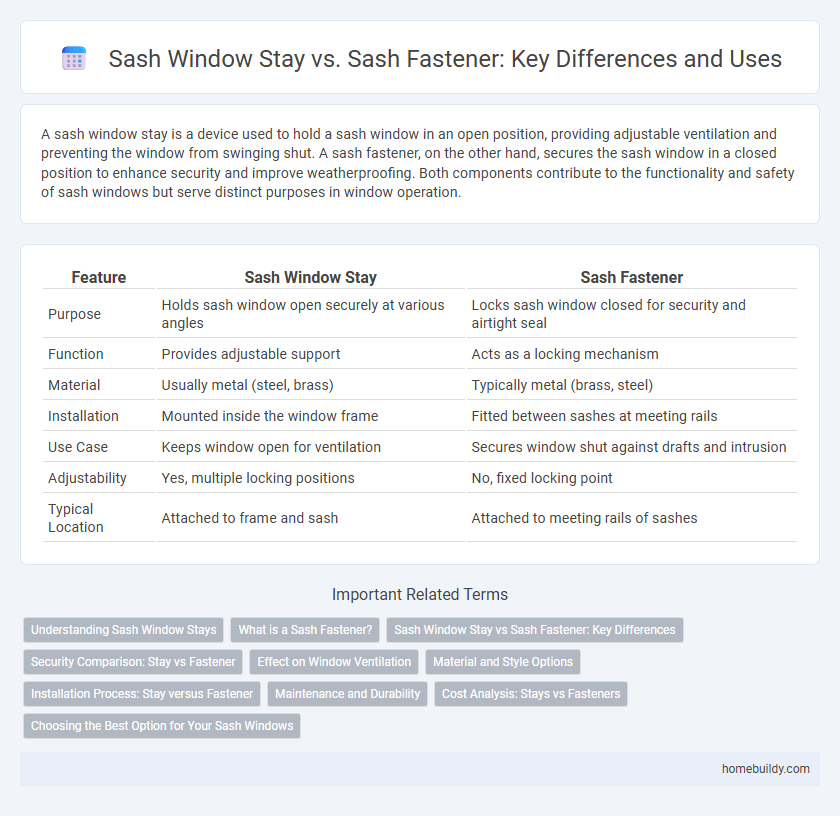A sash window stay is a device used to hold a sash window in an open position, providing adjustable ventilation and preventing the window from swinging shut. A sash fastener, on the other hand, secures the sash window in a closed position to enhance security and improve weatherproofing. Both components contribute to the functionality and safety of sash windows but serve distinct purposes in window operation.
Table of Comparison
| Feature | Sash Window Stay | Sash Fastener |
|---|---|---|
| Purpose | Holds sash window open securely at various angles | Locks sash window closed for security and airtight seal |
| Function | Provides adjustable support | Acts as a locking mechanism |
| Material | Usually metal (steel, brass) | Typically metal (brass, steel) |
| Installation | Mounted inside the window frame | Fitted between sashes at meeting rails |
| Use Case | Keeps window open for ventilation | Secures window shut against drafts and intrusion |
| Adjustability | Yes, multiple locking positions | No, fixed locking point |
| Typical Location | Attached to frame and sash | Attached to meeting rails of sashes |
Understanding Sash Window Stays
Sash window stays are essential hardware designed to hold the sash window in an open position securely, providing stability and safety. Unlike sash fasteners, which primarily lock the window shut to enhance security and weatherproofing, sash window stays control the window's movement and angle when opened. Understanding the function and types of sash window stays ensures proper ventilation and safe operation of traditional sash windows.
What is a Sash Fastener?
A sash fastener is a hardware device used to securely lock sash windows, ensuring tight closure and improved security. Unlike a sash window stay, which primarily controls the window's opening angle and ventilation, a sash fastener firmly holds the two sashes together to prevent unwanted movement or intrusion. Installing a sash fastener enhances window stability and provides an essential locking mechanism for traditional sash windows.
Sash Window Stay vs Sash Fastener: Key Differences
Sash window stays and sash fasteners serve distinct functions in traditional window designs, with sash stays primarily controlling the window's opening angle and securing it in position, while sash fasteners focus on locking the window firmly to enhance security. Sash window stays are often adjustable metal arms or stays that hold the sash at various angles for ventilation, whereas sash fasteners are locking mechanisms that tightly seal the sash to prevent forced entry and drafts. Understanding these differences is crucial for selecting the right hardware to balance ventilation needs and security in sash windows.
Security Comparison: Stay vs Fastener
A sash window stay provides supplementary security by restricting the window's opening range, preventing forced entry while allowing controlled ventilation. In contrast, a sash fastener tightly locks the sash in place, offering a more secure and tamper-resistant seal against break-ins. For enhanced window security, combining sash stays with robust sash fasteners ensures both controlled airflow and maximum protection against unauthorized access.
Effect on Window Ventilation
Sash window stays control the position and angle of the window, allowing adjustable ventilation by holding the sash open at varying widths. Sash fasteners primarily secure the window closed, limiting airflow control and reducing ventilation options. Effective window ventilation relies more on the adjustable nature of sash stays than on the locking function of sash fasteners.
Material and Style Options
Sash window stays and sash fasteners differ primarily in material and style options, with stays commonly crafted from wrought iron, brass, or stainless steel to provide robust support and a traditional aesthetic. Sash fasteners often feature polished brass, chrome, or antique finishes, offering a more decorative appearance while securing the sash tightly for improved insulation. Both options accommodate various window designs but stays generally emphasize functionality and durability, whereas fasteners prioritize elegant detailing and enhanced locking mechanisms.
Installation Process: Stay versus Fastener
The installation process for a sash window stay involves securing the stay arm to the window frame and the sash to control the window's opening angle, typically requiring precise alignment for effective support. In contrast, a sash fastener is installed by fixing two interlocking parts--one on the sash and one on the frame--to lock the window securely when closed. While stays prioritize adjustable ventilation and safety, fasteners focus on providing a robust locking mechanism, each demanding different tools and mounting techniques tailored to their functional roles.
Maintenance and Durability
Sash window stays require regular lubrication and inspection to maintain smooth operation and prevent rust, ensuring long-term durability. Sash fasteners, while providing secure locking mechanisms, often need less frequent maintenance but should be checked for wear to maintain window security. Choosing high-quality materials for both stays and fasteners enhances resistance to weathering and prolongs the lifespan of the window hardware.
Cost Analysis: Stays vs Fasteners
Sash window stays generally cost less than sash fasteners due to simpler design and fewer materials required, making them a more budget-friendly option for securing windows. Sash fasteners, while typically more expensive, provide enhanced security and airtight sealing benefits, which can reduce long-term energy costs and maintenance expenses. Choosing between stays and fasteners depends on balancing upfront expenditure with potential savings on insulation and durability over time.
Choosing the Best Option for Your Sash Windows
Choosing between a sash window stay and a sash fastener depends on your priorities for security, ventilation, and ease of use. Sash window stays provide adjustable ventilation control by holding the window open at various angles, ideal for airflow and safety, while sash fasteners primarily secure the window firmly closed, enhancing security and weather resistance. For optimal functionality, combining both allows controlled ventilation with reliable locking, ensuring both safety and comfort in sash window operation.
Sash window stay vs Sash fastener Infographic

 homebuildy.com
homebuildy.com